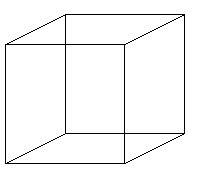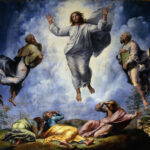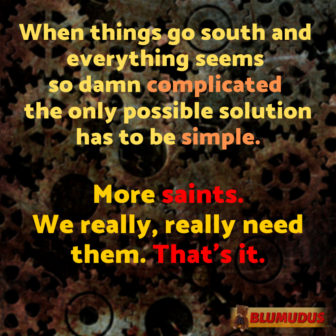The Solemnity of the Most Holy Trinity – Year A
On the Sunday of this festivity we celebrate one of the most difficult mysteries of the Christian faith: the Trinity of God.
One in three Persons, equal and distinct: Father, Son and Holy Spirit. They are not three gods, he is one God.
Not sure how to explain this…
And the linked Sunday readings unfortunately don’t help much.
In order to write this piece, I tried to draw inspiration and get useful teachings from a remarkable book; one of those books that most people may begin to read, only to give up after a few pages, overwhelmed by a sudden headache: Theology and Sanity by Frank Sheed.
A hard to read text if you’re not in the mood, yes… but for someone who’s able to follow a slightly more abstract discourse, this is a surprisingly straightforward, no-nonsense essay, which follows a logical line of reasoning that is far from abstruse; in fact, explanations are relatively simple, taking the necessary time to develop concepts that were indeed complicated.
Unfortunately there is no Italian edition of Sheed’s works, but if a publisher wants to give me a shout, I’d be happy to take care of the translation.
Unfortunately (that’s 2…) I had read that book several years ago, and when a few days ago I picked it up again, looking for a metaphor that I was expecting to find right there… Maybe due to my being short on time… I couldn’t find it! I’m so ashamed. At this point I don’t know if my memory is playing tricks on me: maybe I read it elsewhere. Well, I’ll present it anyway, as best as I can remember/reinvent it.
Let’s go back to the crucial topic.
The Second Reading brings us to the end of the Second Letter to the Corinthians; these are the concluding words of Paul, as a farewell:
The grace of the Lord Jesus Christ
and the love of God
and the fellowship of the Holy Spirit be with all of you.
This is one of the many trinitarian formulas found in the NT; they sound beautiful, perhaps because we are used to hearing them reproposed in the liturgy; perhaps poetic and musical (think of the sign of the Cross and Baptism formula). They have the advantage of letting you approach the idea of God from various angles, without reducing the whole endeavor to some apparently simple, yet fallacious statement, as it would have been if we had relied on the limited human wisdom of the witnesses. A kind of hasty answer as Muslims and anti-Trinitarians insistently ask for: “Show me where it says that 1 = 3!”
But then… do these formulas really enlighten us on the nature of the Trinity, and on why a mystery so difficult even to discuss has been proposed to us as a basic teaching of our faith?
Not exactly. Yet they give us something to chew on: in this case, grace is attributed to the Son, love to the Father, and the unity to the Spirit. So could such a formula be an indication that there are particular aspects, or perhaps “tasks” that each of the three Persons undertakes?
No. Well… yes and no. We’ll get to this later.
First result: a proper priming for research.
The fundamental point here is to understand the crucial role of the Trinity as a model of revealed doctrine: precisely as it is abstruse, it forces you to admit that you’re inadequate, unable to explain things by taking your mind, your experience, your imagination as a starting point. On the contrary, you have to accept facts that come from an external reality, and are super difficult to understand. A lesson in humility, but also a seed for the scientific method: you don’t have to act like philosophers, who come up with axioms, arbitrary premises, and then think about their consequences, deductively. You have to act like scientists, who discover something weird out there, then desperately try to find an explanation, inductively.
One wonders why science was born in Christian lands…
It could be one of the most important, yet usually ignored, results of this doctrine! The method, an offspring of the difficulty itself. Having to face hard, incompressible facts.
OK, but there must be a more straightforward reason, something meaningful for our intellects, if God wanted to reveal this detail of himself, right? Um…
Unsatisfactory explanations.
Now, schemes like this are often used to explain the trinity:

which in the end does nothing but confirm, in another form, a purely linguistic content: it only says that the Father, Son and Holy Spirit are distinct persons (one is not the other), but they are the same God, in some way.
This didn’t really clarify anything: how is it that there are 3, yet also 1? This image seems to try to satisfy the request for an explanation, without giving any actual explanation.
Yes, we get it, it’s a mystery, but…
First of all, let’s dispel a myth: mathematics has nothing to do with it. No one has ever claimed that 3=1.
Persons and nature.
They are 3 persons, 1 God.
God’s nature is one. This answers the question: What is this being? It’s God!
Within a correct framing, by understanding how things necessarily work, God can only be one.
(God, for example, is omnipotent: there cannot be others, otherwise they’d limit each other).
Being a person instead answers the question: who is this? The three persons are equal, in the sense that there can be no hierarchies, none is better, or greater, than the others; but distinct. Since those persons interact, it is not a solitary God.
a. I am a man, this is my nature: it’s what I am. There are many others, separate from me; I’m an imperfect creature.
b. I am Alessandro. this is my person: who I am.
a. Instead the nature of God is the same one: as God the Father, God the Son, God the Holy Spirit. One nature, perfect, existing beyond time and space, eternal. Creator, as an unnecessary bonus.
b. But the three persons somehow are distinct, and they act and interact; for example God the Father creates the world, but through the Son.
Mysterious properties
Indeed, the fact that the Son is a son is perhaps the most surprising aspect: he is begotten, not created. He is not born from something else like the beings of this world, nor is he created out of nothing like our universe; he instead exists beyond this dimension; improperly, to try to distance the image from our very limited human affairs, we say that “he existed before all things”, as if time were an absolute reference frame. But we needed to express the idea that he’s the First Cause: the concepts of before and after are our way of describing cause and effect.
So there’s this father-son relationship, without the father being “older”.
And the Spirit? It’s sent, blown, spirated, effused… both by the Father and by the Son.
The idea, which is already prefigured by the Old Testament, is that Wisdom has always been found alongside God the Father; the ordering principle of all things, which I like to indicate using the Greek term of the NT, used by John: Logos, which we often translate Word: it is enough for God to “say”, to think something, to obtain it in a perfect way. His word is not just a symbol, a means of communication. In a certain sense, we would like to say, Jesus is the thought of God. As such, given God’s perfection, he is not even something separate or imperfect. He is himself God, inseparable, without being the same person.
And the other theological intuition that I will limit myself to reporting is that the Spirit is first of all the Love that is realized between the other two persons. This is why he “proceeds from the Father and the Son” (ah, these formulas that we learned in our youth!)
Let’s always remember our inadequacy!
Still confused? You should, even if you were already familiar with the subject.
Our abilities are limited.
In the words of the aforementioned Frank Sheed:
To argue too confidently about the inner being of the Infinite is to overlook the myriad things that we do not know about it: our premises are a shadow and an approximation of the Infinite Reality: how can our conclusions be sure?
We only see dimly; we’re full of doubts.
Dealing with complexity: projecting onto a more accessible plane
I always like to bring the example of the 3 dimensions, when it comes to discussing topics that are beyond our ability to understand. Imagine if you were a two-dimensional being. They present you with a cube, and you have no sense of what it might be, you can’t even see it! If they want to show you this incomprehensible thing, as it crosses the two-dimensional plane, you can only see the intersection, still getting a partial view. By moving it, the observer of the 2D world would think of a two-dimensional geometric figure that changes.

Here it is, represented in 2D. Again, a little flat man wouldn’t understand anything: he could say that one side crosses the other, that there are a few geometric figures, overlapping.
Let’s complicate things a bit; we see in 3 dimensions. What if we were presented with a cube in 4 dimensions?
Well, there’s the tesseract, which represents the next step: from square (2), to cube (3), to tesseract (4).
And they didn’t just limit themselves to naming this thing, for fun. In our small way we can appreciate what can be done with projections on 3 dimensions. And mathematicians love to explore worlds almost beyond our reach.
When you watch these sorts of animations for the first time you may be blown away. Cannot put my finger on it… Yet this is only about adding a spatial dimension. According to the most recent theories, there are many more. Let’s say, uh, 11?
Here we’re simply discussing complex objects that are part of the order of creation; almost at our level.
How much more unfathomable is the idea of God, an infinite being!
Yet, as misleading as it is to see a cube as just a square, through a projection of God onto some more relatable aspect of His manifestation, perhaps we get at least a partial view of Him.
There is a principle that theologians have toyed with for centuries: when we discuss the Trinity, we speak of appropriation: many actions, qualities, attributes would belong to all three persons, but can be referred to a specific Person, as if they were specific to him. In this way we somehow get closer to God, being able to see him from a particular angle; we don’t understand everything, but we appreciate what we see. Like when you look at the 3D projection of the tesseract.
How to distinguish a more or less justified appropriation from what is instead a true and proper property of the Divine Persons, such as for example being a father and being a son? I honestly don’t want to get into this, I’ll leave it to theologians. I am satisfied with my beautiful orthogonal projection, as simple as it gets, which gives me back an already quite complex, rich, instructive image of God. We will come back to this “instructive” angle later.
As a starting point, the bare minimum is to avoid to apply our arbitrary mental categories, as if we were to define or (consequently) limit God.
Frank Sheed again:
the specific appropriations that we make remind us that the Father is Origin and Power; the Son, Knowledge or Wisdom; the Holy Spirit, Love.
Out of curiosity, going on a search, I find that, in their explanation of the concept of appropriation, the famous Italian encyclopedia Treccani uses a similar example, but indicates eternity in place of origin, and truth in place of knowledge.
Another important appropriation, given that we didn’t say much of the Spirit: the Holy Spirit is God who helps the Church, who’s present in us, who guides history. Only on rare occasions does Scripture point to the same concepts (e.g. dwelling in us) for Jesus or the Father.
Finally, we should remark how the act of creating the universe by God is a just a plus, a gratuitous act of generosity. Last quote from the good Frank Sheed, God bless him:
It may be worth a moment’s pause to consider the sequence (understanding that it is not a sequence in time but in order of being)
The Father generates the Son;
Father and Son as one principle spirate the Holy Spirit;
Father, Son, and Holy Spirit as one principle create the universe.
Well, you must be tired by now, let’s have some playtime!
First, a premise: this is still only our stammering: inadequate mental images; projections on our plane of a much more complex “geometry”. That said, here’s the promised metaphor.
Close your eyes and get ready to take a journey with the mind. Take a deep breath. OK, read the instructions first, then close your eyes, etc.
You can come up with a thousand different scenarios, but to have a concrete point of reference I’ll develop one.
You are on a very long, almost deserted beach. A beautiful day, the sea is calm. You’re leisurely walking along the shoreline. Now you meet a child armed with a bucket and a toy spade, who’s trying to fill a hole in the sand with sea water. You almost open your mouth to speak, but change your mind and carry on, undaunted. Suddenly, out of nowhere, as if from a mist, a frightening number of horsemen appear. They gallop on the beach, running towards you. Let’s make them horse archers. They’re about to trample you. Suddenly a hail of arrows shoots off, but as they descend they’re deflected by a mysterious force. You perform a couple of Matrix-style evasion moves, and bam: the threat is gone. You’re still there, unscratched, maybe wearing a perfectly pressed evening dress/tuxedo (depending on your genital persuasion), while we’re at it. Oh golly, an evening dress on the beach?
Try to draw this scene in your mind, with your eyes closed… and please, come up with an ending of your liking. Or choose a different scenario, it doesn’t matter.
Done? Here, contemplate the story you’ve created. It’s only in your mind; it doesn’t have its own reality; it won’t last, it’s already a memory. It was inaccurate right away, it will be even more so as you forget the details.
Well, in this situation…
1. there’s you, eyes closed in front of a lit screen, intent on thinking. Author.
2. Then there’s you, a character from your own story, immersed in the reality you’ve imagined. Protagonist.
3. Finally there is your role as someone who controls the unfolding of the story itself, determining the sequence of events. Narrator.
Well, now imagine how things change for God. If God thinks about anything, in his perfect and infinite nature, that object of his thought isn’t just a set of ideas, a possibility, a model of things that could exist. By simply saying “Let there be light”, the light exists. The scenario isn’t just imagined by God, it is created.
Then we have
1. God the Father who creates, as the Principle: Author of all things;
2. Jesus Christ incarnated, literally immersed in history;
3. the Holy Spirit who defines the outlines of this story, who develops the plot.
This is the exact same scheme, similar to the story imagined by you; only this time what God thinks is also a reality.
Nice little representation, isn’t it? Don’t you concur we’ve come to understand something more through this?
I said: all this is instructive.
I don’t pretend to know the various ways in which this knowledge of the Trinity can serve our edification, but I’ve already mentioned one in the beginning: the First Result. Furthermore, I’ll just indicate some ideas, indeed seeds for very long, hard and productive mental journeys…
-On Being: what are the boundaries of individuality? Isn’t the Communion of the Saints perhaps based on the idea that, even imperfectly, as in a mirror, we too are destined for a kind of deep, intimate union, which nevertheless does not deprive us of being distinct persons?
-God creates… Why does he do it? He wants to love us too… he loves the richness of complexity…
-The idea of a Spirit who is Love, if internalized and contemplated, as we have perhaps been unable to do so far, can be very productive.
-Meditating on the incarnation of Christ, his sacrifice… Here one truly enters a maze of concepts so profound that it would take a lifetime to try to explore them, and it wouldn’t still be enough.
-And what about the surprising connection between a Person who is the wisdom, the truth, the perfection of God’s Ordering Thought …. and his being a sacrificial victim, after assuming human nature…!
I confess that I cannot go beyond the threshold of these problems.
However, there is a theme that I believe is important, deserves to be underlined and, all things considered, it’s not hard to explain. Again, about the Holy Spirit.
When Jesus in Matthew’s Gospel (12:31-32) speaks of sins against the Spirit that will not be forgiven, I think he means that there’s a rejection of God that is too radical not to compromise your love relationship with Him.
In fact, believing or not that there is some Abstract Principle (God the Creator) at the origin of all that exists, is a very cerebral question, capable of affecting your life only marginally; respecting (or perhaps not knowing, not having understood) the figure of Jesus is also an important but not essential aspect: think, for example, of those who admire an imaginary version of Jesus, as seen through their eyes. Additionally: the sacrifice on the Cross is still something most people may easily admire and respect, if from a distance.
No, faith gets its foundation from our attitude towards the Holy Spirit: a faith in the presence, invisible but active, of God in our everyday lives, in the Church, in the fabric of history. If we reject God from our reality, this is where our throwing away our salvation also comes into play.
I read that St. Thomas Aquinas taught that there are as many sins against the Holy Spirit as there are ways to reject God’s help to keep man from sinning. Think about it! The PRESENCE of God… a constant presence in our lives. Do we still believe this? Factually?
After all, isn’t there perhaps a deep connection between this, between the classic sins listed by Aquinas (despair of salvation, presumption of salvation without merit, etc.) and the modern vision of a world left to itself, where there are no moral imperatives, universal truths, consequences to our shameful actions?

This is 3 in 1 according to Wikipedia. Am I to be taken seriously?










































